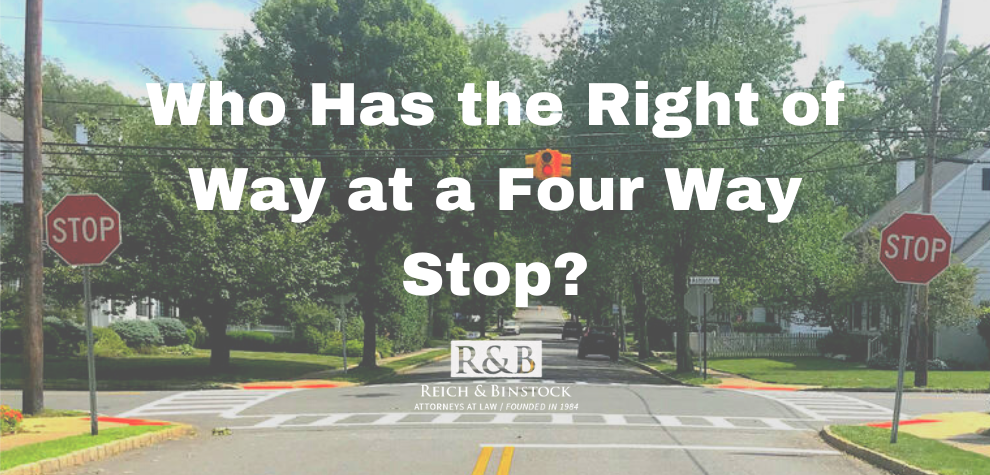Failing to follow stop sign rules results in approximately 70% of all crashes in the United States. This is likely because many drivers don’t know who has the right of way at a four way stop. Reckless or distracted driving are also common factors in stop sign accidents. If you or someone you love suffered severe injuries or property damage from a stop sign accident, you may be entitled to significant compensation. Call Reich & Binstock today at 713-622-7271 for more information.
Who Has the Right of Way at a Four Way Stop?
Possibly the most important rule to remember is that whoever gets to the stop sign first, gets to go first. But what if two cars get to the stop sign at the same time? In this case, the driver on the right has the right of way. However, the rule for who has the right of way at a four way stop when two cars are across from each other depends on the direction of travel.
- Both drivers can go if they are driving straight or turning right.
- If one car is signaling a turn and the other isn’t, the car going straight has the right of way. This same rule applies at two-way stops as well.
- If one car is turning right and one is turning left, the right-turning car has the right of way.
Who Has the Right of Way at a Left Turn?
Left turns are arguably the riskiest moves drivers can make, especially if left turns aren’t dictated by a traffic light. In fact, left-turning drivers cause approximately 53% of intersection accidents. Meanwhile, only 5.7% of intersection crashes involve right-turning drivers according to the National Highway Traffic Safety Administration. If both cars at an intersection are turning left, they can turn at the same time if there’s enough room on the road to do so. If not, visual communication with the other driver will establish who goes first. This rule also applies to four cars who are at a four way stop at the same time. They all must visually communicate to decide who goes first.
Right of Way Rules for Cyclists
Bikes are considered vehicles, so they must follow the same rules as drivers for the sake of everyone’s safety. However, fatal bicycle accidents still happen. According to the National Highway Traffic Safety Administration, 846 bicyclists were killed in crashes in 2019. To best prevent any injuries or death, it’s important for bicyclists to ride on the right side of the road. Additionally, bicyclists can leave the right lane when turning left. Meanwhile, drivers must give bicyclists four feet when passing them, and bicyclists don’t have to move further to the right.
Who is At Fault in a Four Way Stop Accident?
If another driver doesn’t properly follow four way stop rules, then they are at fault for the crash. Because of that, you can file a personal injury claim to receive compensation for your damages. Occasionally, it’s hard to figure out who’s at fault for a four-way stop crash. If you’re unsure who’s at fault, these are the questions you should ask:
- Did the other driver fail to stop at their stop sign?
- Who has the right of way at a four way stop?
- Did you arrive at the stop sign at the same time as the other driver?
How to Prove the Other Driver Was Negligent
In order to receive compensation for your damages after a car crash, you must prove that the other driver was negligent. Basically, if the other driver didn’t properly follow the stop sign rules, they are negligent. To prove negligence to a court of law and an insurance company, you must report the crash, document the crash scene, keep proof of damages, and protect your rights.
Report the Crash
In Texas, law dictates that citizens must file a police report if a crash resulted in any injuries, deaths, or at least $1,000 worth of property damage. Filing a crash report will create a paper trail of evidence that will support your case. As a result, you may receive compensation.
Document the Crash Scene
Another way to strengthen your case against a negligent driver is to document the crash scene. Make sure to take pictures of your injuries, any damage to your car, and the entire crash scene. You also need to get the negligent driver’s name, their contact information, and their insurance policy information so that you can file a claim with their insurance. Lastly, write down the exact details of the accident so that you can keep your facts straight.
Keep Proof of Damages
Make sure to keep all medical bills, receipts, and paid time off from work because this documentation will strengthen your case. A Houston personal injury lawyer can give you direction on what documents to keep and which ones to throw away.
Protect Your Rights
Lastly, you need to protect yourself and your rights, especially when the negligent driver’s insurance company contacts you. Be sure to speak with your lawyer before giving an insurance company information about your crash. This is crucial because insurance adjusters are always searching for ways to save money by exploiting crash victims.
Common Causes of Stop Sign Accidents
Car accidents happen every day for hundreds of reasons. But what are the main causes of accidents at stop signs?
- In a hurry: many people on the roads are in a hurry to get to work, to pick up the kids, to make it on time to an appointment, the list goes on. Because of these reasons, many drivers don’t take the time to fully stop at a stop sign. This often leads to car accidents.
- Reckless driving: occasionally, drivers won’t even see a stop sign when they’re driving. As a result, they will drive straight through it without realizing.
- Distracted driving: some drivers text and drive, which is one of the most dangerous activities you can do on the road. Because of texting and driving, many drivers will completely miss a stop sign.
- Drunk driving: unfortunately, about 28 Americans die every day in drunk driving accidents. Drunk driving is also a common cause of stop sign accidents.
Common Injuries From Car Accidents
Approximately 4.4 million Americans are seriously injured in car accidents annually. Depending on the severity of the accident, a victim can suffer a variety of different injuries.
Traumatic Brain Injuries
One of the most common causes of traumatic brain injuries (TBI) are car accidents. A TBI is when the brain is severely damaged by a blow to the head or a piercing injury. Within five years of an injury, approximately 50% of patients with a TBI will die or continue to get worse according to the CDC.
Spinal Cord Injuries and Paralysis
A driver can suffer significant spinal cord injuries as a result of a car accident. Spinal cord damage can result in complete or partial paralysis.
Back Injuries
One of the most common injuries associated with even the most minor car crashes are back injuries. Severe back injuries can result in long-term pain and medical attention, meanwhile regular chiropractic work can often resolve minor back injuries.
Neck Injuries and Whiplash
Another common injury from even minor car crashes are neck injuries. In fact, driving as slow as 15 miles per hour can cause a neck injury. Whiplash is the most common term used to describe muscle, ligament, and tendon injuries in the neck.
Burns
A driver can suffer severe burns if a car happens to catch on fire after a crash. Severe burns may require surgery or skin grafting to repair.
Cuts, Bruises, and Road Rash
Drivers can suffer cuts from broken glass or torn sheet metal as a result of an accident. Additionally, bruises and road rash are common crash injuries.
Broken Bones and Fractures
Broken bones are an incredibly common injury due to car accidents. Drivers can suffer broken legs, ribs, arms, ankles, wrists, and more. The severity of a broken bone can range from a simple break, that may need an adjustment and a cast, to compound fractures that may need surgery to fix.
Knee, Ankle, and Foot Injuries
Knees can easily become injured if they smash into any part of a car during an accident. A driver can suffer a range of knee injuries that include bruises, fractures, or even meniscus and cartilage tears. As for the ankle and foot, sprains and fractures are common in even the most minor accidents.
Statute of Limitations for Four Way Stop Accidents
In Texas, a car crash victim must file a personal injury or a property damage lawsuit within two years from the date of the accident. If a crash victim waits longer than two years to file a claim, they can lose their right to receive compensation for injuries or property damages.
Compensation for Stop Sign Accident
If you suffered serious injuries from a stop sign accident, you can receive compensation for:
- Past and future medical expenses
- Past and future wage loss
- Loss of earning capacity
- Pain and suffering
Call Reich & Binstock Today
If you or a loved one has been seriously injured in a crash because the negligent driver doesn’t know who has the right of way at a four way stop, you may be eligible for compensation. At Reich & Binstock, we offer compassionate legal help to car crash victims. Call us today at 713-622-7271.














